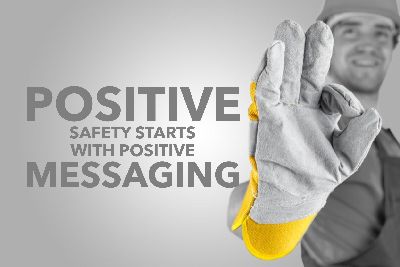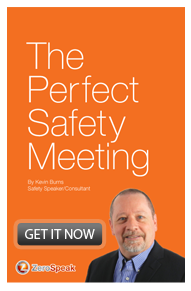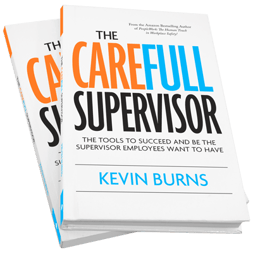Telling people to avoid a particular action or behavior does not automatically result in the right actions and behaviors.
 Don't do this. Don't do that. Don't do what he did. Beware of the danger. Employed use of gruesome photos of severed and mutilated body parts. Safety messages are regularly reinforced negatively. Negative reinforcement does not automatically create positive safety behaviors.
Don't do this. Don't do that. Don't do what he did. Beware of the danger. Employed use of gruesome photos of severed and mutilated body parts. Safety messages are regularly reinforced negatively. Negative reinforcement does not automatically create positive safety behaviors.
A recent series of statistics offered some insight of how people react and behave to the words and suggestions of others.
Let's take a look at how you allow yourself to be influenced by others when choosing to buy a product. Do you read the reviews on a product before you buy? Do you research what others have had to say about a product or service? Have you ever asked a friend or family member to recommend a tradesperson, a plumber, an electrician, a handyman, a carpet cleaning company, etc.? Have they ever told you which ones to steer clear of?
A study by Dimensional Research took a look at how we react and use online reviews. The findings have implications about how we react to communications.
In the study, 90% of people were swayed by positive reviews about a product. They were swayed enough to purchase the product themselves. On the other hand, 86% of on-line shoppers were swayed by negative reviews of a product. They were swayed enough to not purchase the product. You might think that this is a near dead-heat. But it's not. You have to consider what the reviews actually swayed people to do, or not do. The positive reviews swayed people to take action and buy. The negative reviews swayed people to take no action and not buy. Negative reviews did nothing to cause people to act. The negative reviews caused people to stop acting.
How can safety use this information? By studying how your safety communications are offered. Are you asking people to act in a positive way, to take an action? Or, are you telling people what not to do? Here is a a list of three reasons that a negative message could be undermining your safety efforts:
1There is no direct correlation between negative stories and positive actions. Giving people a list of things to not do, to avoid a particular action or behavior, does not automatically result in the right actions and behaviors. Showing photos of a severed finger does not automatically increase use of safety glasses, hearing protection or gloves. Showing photos of car accidents doesn't automatically result in people putting down their phones when they drive. Showing photos of forest fires doesn't stop people from flicking their cigarette butts out the car window. A negative review of a product may stop the purchaser from buying that product but there is no direct positive-behavior outcome (buying the better product). In fact, before people buy the better product, they will still want to read the reviews to satisfy themselves that they are making the right decision.
2Don’t, stop and never are not complete instructions. These negative-action (absent actions) words are not a complete and actionable step. Telling a dieter “don’t have the chocolate cake” is not a complete instruction. What is it that you want someone to do, specifically? It is easy to follow an instruction. It is more difficult to definitively translate the intention of a negative message. Instructions fail when they are missing actionable steps. No one ever enters a grocery store with a list of what not to buy. They go with a list of exactly what to buy. People trying to change their results need specific instructions. In safety, don’t get hurt is not a complete instruction. Neither is stop doing unsafe things. What things specifically? And what actions do you want them to take … specifically? Give them a plan.
3It takes six positive words to overcome one negative word. People do not perform well in a negative environment. The overuse of negative chastising, criticisms and hyperbole do not motivate employees. In fact, research shows that the more negative words are used, the poorer teams perform. People do not automatically see the bright side of negative comments. Criticize performance and there is no automatic reversal of action. Criticize continuously and people de-motivate. Their love for the job and for safely doing the job vanishes. Relationships suffer too. A boss who offers nothing but negative feedback creates a chasm between boss and employee. It will take a lot of positive words to overcome a negative environment.
So what can be done to improve positive working environments and positive safety performance? Do these three things starting today:
- Scour your workplace looking for anything that could be interpreted as negative. Look for posters with cuts or injury. Remove anything with the words don’t, never or stop in them. And remove PowerPoint slides from your deck that focus on mistakes/failures instead of success.
- Find better ways to show positive growth. Good coaches find ways to tweak performance one small step at a time. Positive reinforcement pushes better performance. Use positive words to build positive engagement. Study each word you use. Is it positive or negative?
- Stick to safety. If you want your people to be better in safety, expose them to good safety behaviors - not messages and stories of injury. Safety is not the absence of injury. Focus beyond mere compliance. Find ways to talk about positive safety and in a way that others want to be part of it.
 The benefits of doing safety well are positive. The feeling of creating a championship team of high performers is positive. Solid teamwork is positive. Leadership is positive. Build your safety program on positive reinforcement and positive performance feedback. It’s easier than you think.
The benefits of doing safety well are positive. The feeling of creating a championship team of high performers is positive. Solid teamwork is positive. Leadership is positive. Build your safety program on positive reinforcement and positive performance feedback. It’s easier than you think.
Kevin Burns helps organizations integrate caring for and valuing employees through their safety programs. In addition to working with and facilitating discussions between all levels of management and supervisory, Kevin can also give engaging, entertaining and inspiring presentations to front-line employees at safety meetings. Kevin Burns is a management consultant, safety leadership speaker and author of 9 books. He is based in Calgary, Canada.
©2016 ZeroSpeak Corporation and Kevin Burns.
No part of this post may be reproduced without the expressed consent of the author.


